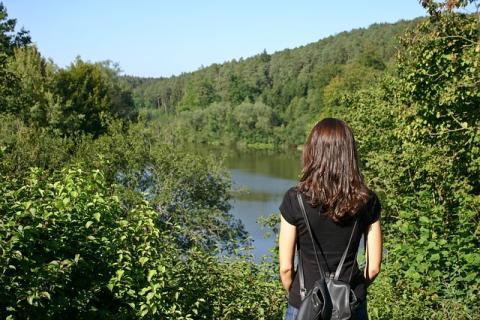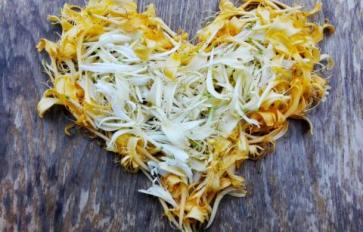
Want to make an impact on the earth but don't know how? It might be easier than you think. See, back when I first started learning about the environmental stress our world is under, I felt overwhelmed. I wanted to do everything I could to help the environment, but didn't know where to start. After all, there are so many problems to address: Pollution, harmful chemicals, endangered species, and pesticides are just a few. That said, there are ways you can help the earth without losing your marbles. Here are five easy ways to start living a more natural, eco-friendly lifestyle. And trust me, they won't overwhelm you.
Use a glass straw (not a plastic one)
I'm the proud owner of a glass straw and let me tell you this: Best investment ever (for the environment, that is). Did you know the plastic in straws are made from a petroleum byproduct? Not to mention they're designed for single-use consumption (which means you use them once and into the trash they go). But here's the thing: Plastic is not biodegradable. It just sits there – in landfills, in oceans, in forests. It doesn't do anything but cause harm: Animals eat it, and waterways are constantly polluted with it. Not to mention most plastic leaches toxins over time, causing damage to any area it winds up in. So do the world a favor: Just buy glass straws. They're much prettier and way more eco-friendly. Plus, they're surprisingly durable. I got mine from Strawesome, a company that make straws in various colors, shapes and designs.
Forage for your own food
I've talked about foraging before (here are 3 plants I highly recommend you know how to identify and harvest), so I won't go into too much detail here. Suffice it to say, foraging is a great way to connect with the environment. Most of us take the food we eat for granted (there's everything we could ever want in the grocery store), but think about if you didn't have access to it. Would you still survive? Frankly, probably not (unless you knew how to forage and grow crops). Foraging is a sustainable way to eat because foragers do not over-exploit their environment. They take just enough to sustain themselves and let the plants live on (so they can keep producing more food). Modern agriculture, while convenient, eliminates biodiversity. That's because most of it consists of monoculture-based food farming (which hurts animals too – specifically bees!). Monoculture farms are farms that only produce one crop year after year using the same land. There's no diversity and the crops are usually sprayed with pesticides (another bee-killer). This is where foraging comes in: While you don't have to forage for all your food, foraging any amount is better for the environment. It makes a statement that you won't tolerate big businesses ruining the earth. Besides, in grocery stores, you're disconnected to where the food comes from. With foraging, you'll know exactly where the plant you're eating comes from and even be picking it yourself. Just make sure you know which plant is which: Even the well-trained eye can make mistakes. Your best bet is to take a guided tour to help keep things safe (and legal), and to invest in a fantastic foraging guide for the plants native to your area.
Pee in the shower (yes, really)
I'll bet your mother always told you "never pee in the shower." Well guess what? She was wrong: You should pee in the shower! As icky as that might sound, I'm not saying it just so you can defy your mother. Or gross her out. I'm saying it because a household can save nearly 2,000 gallons of water a year (on average) by not flushing once a day. Think about that. That's a lot of water saved (and not wasted). Also, those who have an older, pre-1992 model toilet can save even more than that: Twice as much water, actually. Pretty cool, right? Well, maybe not if you're squeamish. Just remember this: Urine is normally completely nontoxic and sterile. That's because your urine is 95 percent water (just a little FYI). The only time it's not is if you have an infection. If your urine is cloudy, you could have a urinary tract infection. So if your urine is cloud-free, keep things neat and aim for the drain.
Buy a reusable water bottle
Plastic water bottles are the bane of my existence: They cause so much pollution and harm to the environment, and yet they're everywhere. On a casual stroll, I'll spot at least five of them (and not in stores, I mean on the ground). Not surprising (though it is certainly disturbing) considering there are 1,500 water bottles being consumed per second in the United States alone. I don't even want to think about what that total is with all the other countries added to it. Not only that, but they're hazardous to human health: Plastic leaches chemicals over time, so the longer the water sits inside the plastic bottle, the more chemicals it absorbs. Those two main reasons are why I made the switch to a reusable water bottle made out of stainless steel. I truly recommend it because it can store not just water, but hot drinks (like tea or coffee) as well. If you'd like, you can also get a reusable glass water bottle, but I didn't because I'm afraid I'll drop and break it. The only problem with these are the fact most reusable water bottles (unless made from plastic), do not come with filters. If that doesn't bother you, you're good to go. If it does, I recommend finding natural ways to filter your water without a man-made filter, like activated charcoal.
Join a community garden
Gardening is fantastic, but if you're anything like me, you don't exactly have the room for it. I live in an apartment (with no balcony, just windowsills), so gardening space is extremely limited. I make do with what I can, but joining a community garden is something I truly want to do. In fact, I'm making it a goal to join one this spring. Why? Because gardening with a group (as opposed to doing it alone) contributes to a sense of camaraderie. It makes you feel good about your neighborhood and like you're helping the community as a whole. Plus, you get to meet new people who can teach you what they know from their own experiences (how to grow certain plants, when to sow specific seeds, etc.). According to the American Journal of Public Health, those who tend community gardens also are more likely to eat more fruits and vegetables. But what are the environmental benefits of community gardening? Obviously there are health benefits, but how do community gardens help the environment more than buying produce from the store? Well, for starters, the food doesn't have to travel as far to get to you, which cuts back on greenhouse gas emissions related to the transportation of food. Not to mention, most of the food you see at the supermarket spent 7 to 14 days in transit. Think about how big of a carbon footprint that causes. What's worse is that 50 percent of the food spent in transit is lost due to spoilage. Community gardens are local, so this usually reduces (or completely cuts) transit time. In other words, less carbon emissions and food waste, more fresh produce! If you don't have a community garden near you, why not start one? Here are some steps you can take to starting your own community garden. There are tons of benefits to it: Here are a bunch more. Now get gardening!








